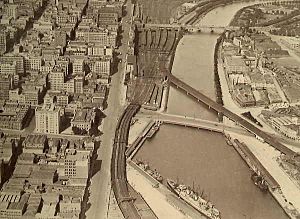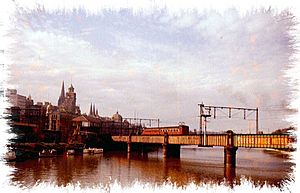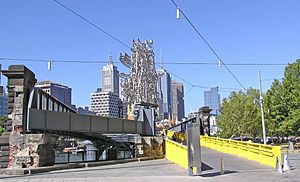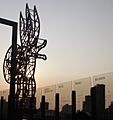Sandridge Bridge facts for kids
Quick facts for kids Sandridge Bridge |
|
|---|---|
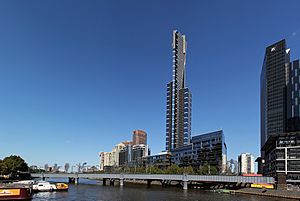 |
|
| Carries | Pedestrians, cyclists |
| Crosses | Yarra River |
| Locale | Melbourne, Australia |
| Characteristics | |
| Design | Steel girder |
| Total length | 178.4 m (585 ft) |
| Width | 17 m (55.8 ft) |
| Longest span | 36.9 m (121.1 ft) |
| History | |
| Opened | 1888 |
The Sandridge Bridge is a special bridge over the Yarra River in Melbourne, Victoria, Australia. It used to be a railway bridge, but in 2006, it was changed into a path for people walking and riding bikes. The bridge is about 178.4 meters (585 feet) long and crosses the river at an angle. It's the third bridge built in this spot and is an important historical landmark in Victoria.
A Bridge Through Time
The very first bridge here was built in 1853. It was for Australia's first passenger railway line! This line connected Flinders Street in Melbourne to Port Melbourne by the sea.
In 1858, that first bridge was replaced. A new wooden bridge was built to carry two railway tracks. It was also built at a different angle to make the train's journey smoother.
The bridge you see today was finished in 1888. It was designed to have four railway tracks. This bridge was one of the first in Melbourne to use strong steel beams instead of iron. A famous engineer, John Monash, even worked on it when he was a young student! The bridge's ends are supported by strong stone and brick structures. In the 1920s, electric power lines were added for the trains.
The trains stopped using the bridge in 1987. The railway lines were changed into light rail (trams). Today, trams like Route 96 and Route 109 use parts of the old railway lines, but they don't go over the Sandridge Bridge anymore.
The Bridge's New Life
For many years, the bridge wasn't used. Then, in 2003, the Melbourne City Council and the government decided to give it a new purpose. They spent $15.5 million to fix it up and turn it into a public space.
In 2005, an artist named Nadim Karam was asked to create a special art project for the bridge. It's called The Travellers. This artwork has ten cool sculptures that represent the many different people who came to Australia as immigrants. Many of these new arrivals would have traveled by train over this very bridge from Station Pier. Nine of these sculptures actually move across the bridge in a 15-minute show!
The updated bridge was opened just before the 2006 Commonwealth Games in Melbourne. It cost a total of $18.5 million. Now, it's a great path for walking and cycling. It connects Queensbridge Square on the Southbank side to Flinders Walk on the north bank of the river.
Sadly, in 2007, some parts of The Travellers artwork were damaged. People used a sledgehammer to break 46 of the 128 glass panels. Each glass panel shares information about Australia's Aboriginal people or the countries where immigrants came from. It cost a lot of money to fix, and city leaders thought about using stronger materials for repairs.
Bridge Facts
The Sandridge Bridge is 178.4 meters (585 feet) long. It's made up of five sections. The longest sections are about 36.9 meters (121.1 feet) long. The bridge is 17 meters (55.8 feet) wide. Its steel beams are 2.74 meters (8.98 feet) high.
Gallery
-
Sandridge Bridge Towards Flinders Street station
-
Melbourne South Bank & Sandridge Bridge
| Preceding station | Disused railways | Following station | ||
|---|---|---|---|---|
| Flinders Street | Port Melbourne line | Montague | ||
| Flinders Street | St Kilda line | South Melbourne | ||
| List of closed railway stations in Melbourne |
Images for kids


